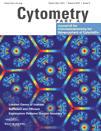
Experiment Overview
| Repository ID: | FR-FCM-ZZTQ | Experiment name: | Human PBMC and lung single cell digestion stained with OsO4 and WGA | MIFlowCyt score: | 58.72% |
| Primary researcher: | Adeeb Rahman | PI/manager: | Adeeb Rahman | Uploaded by: | Adeeb Rahman |
| Experiment dates: | 2016-09-09 - 2016-09-09 | Dataset uploaded: | Sep 2016 | Last updated: | Oct 2016 |
| Keywords: | [human PBMCs] [CyTOF] [WGA] [cell size] [oso4] [human lung tissue] | Manuscripts: | [27768827] |
|
|
| Organizations: |
Icahn School of Medicine at Mt. Sinai, New York, NY (10029)
|
||||
| Purpose: | To evaluate heterogeneity of WGA and OsO4 staining on a sample containing a mixture of hematopoetic and non-hematopoetic cells | ||||
| Conclusion: | both WGA and Os-192 showed similar distributions of staining intensity across cell subsets (Fig. 4E and F) with distinct populations exhibiting characteristic intensity patterns. Relative expression patterns across CD45 hematopoietic cell subsets were similar to those observed among analogous subsets in whole blood, with myeloid cells showing higher expression than T cells. Notably, we found that CD45-CD326+ lung epithelial cells expressed much higher levels of WGA and Os-192 staining than hematopoietic cells, consistent with their larger expected cell size. Interestingly, some broadly defined populations, such as macrophages, showed heterogeneous WGA and Os-192 expression, suggesting the potential utility of these reagents in revealing additional heterogeneity in complex cellular samples beyond that identified by traditional antibody staining. We conclude that WGA and OsO4 are versatile and complementary assays that can be used to characterize size-related cellular heterogeneity in mass cytometry experiments. | ||||
| Comments: | None | ||||
| Funding: | Funding was provided by the Icahn School of Medicine at Mount Sinai and the NIH Grants P50GM071558 (Systems Biology Center New York), R21CA196418, R01GM104184, U54HG008098 (LINCS Center) to MRB, T32GM062754 to ADS and U24AI118644 to AHR. | ||||
| Quality control: | For quality control, the acquisition event rate was maintained under 400 events/s, and the EQ beads were confirmed to have a median Eu151 intensity of over 1000 to ensure appropriate mass sensitivity. | ||||
